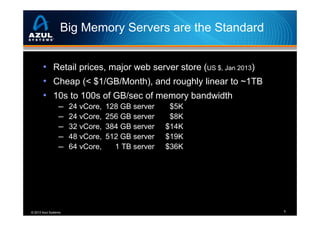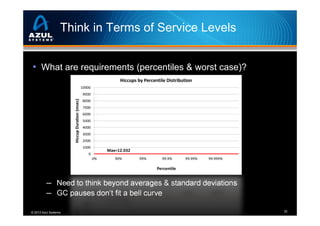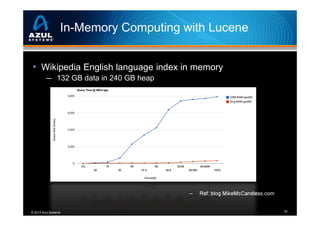Java at Scale, Dallas JUG, October 2013
- 1. Java at Scale: Performance & GC Presented to Dallas JUG October 2013 Matt Schuetze Product Manager
- 2. Where is Java Working? • On the server ─ Enterprise applications: business rules ─ Monolithic & distributed computing • On the client ─ Fat client computing ─ Thin client, browser-based • Embedded ─ Android apps © 2013 Azul Systems 2
- 3. What is Java’s Appeal? • Portable ─ Write once, run anywhere (after testing everywhere) • Productive ─ No bad features: no multiple inheritance, operator overloading ─ Do the Right Thing philosophy (vs. C++ Do the Efficient Thing) ─ Memory management reduces opportunities for error • Efficient ─ Interpreter → JIT compilation → Dynamic recompilation • Generic ─ Scala, Clojure, JRuby & more use Java runtime ─ Byte code is the new target architecture (ANDF) • Scalable ─ Small to large platforms © 2013 Azul Systems 3
- 4. Parkinson’s Law Applied to Software • Hardware grows with Moore’s Law ─ Transistor counts double roughly every 18 months ─ Memory size grows around 100x every 10 years • Application sizes grow with hardware ─ ─ ─ ─ ─ 1980: 100 KB data on ¼ – ½ MB server 1990: 10 MB data on 16 – 32 MB server 2000: 1 GB data on 2 – 4 GB server 2010: 100 GB data on 256 GB server (In-memory data size. Bigger data is cached or distributed.) © 2013 Azul Systems 4
- 5. Big Memory Servers are the Standard • Retail prices, major web server store (US $, Jan 2013) • Cheap (< $1/GB/Month), and roughly linear to ~1TB • 10s to 100s of GB/sec of memory bandwidth ─ ─ ─ ─ ─ © 2013 Azul Systems 24 vCore, 24 vCore, 32 vCore, 48 vCore, 64 vCore, 128 GB server 256 GB server 384 GB server 512 GB server 1 TB server $5K $8K $14K $19K $36K 5
- 6. Has Java Kept Up? How Scalable is it? • How big is your Java heap? ˃ .5 GB ˃ 1 GB ˃ 2 GB ˃ 4 GB ˃ 10 GB ˃ 20 GB ˃ 50 GB ˃ 100 GB • Hardly anyone runs over 4 GB © 2013 Azul Systems 6
- 7. Large Heaps are a Rarity • Survey of heap sizes for Plumbr memory leak detector ─ Source: http://plumbr.eu/blog/most-popular-memory-configurations © 2013 Azul Systems 7
- 8. Why So Few Big JVMs on Big Servers? • Java performance gets worse with heap size ehCache: 10 GB cache, 29 GB heap, 48 GB 16 core Ubuntu server ─ Pause frequency varies with application activity ─ Pause duration varies with amount to scan/copy © 2013 Azul Systems 8
- 9. Think in Terms of Service Levels • What are requirements (percentiles & worst case)? ─ Need to think beyond averages & standard deviations ─ GC pauses don’t fit a bell curve © 2013 Azul Systems 9
- 10. A Classic Look at Application Response • Key assumption: response time is a function of load ─ © 2013 Azul Systems source: IBM CICS server documentation, “understanding response times” 10
- 11. Java Response Has a Different Look • Pauses may track with load, but not in as obvious a way ─ © 2013 Azul Systems source: ZOHO QEngine White Paper: performance testing report analysis 11
- 12. A Few Realities About GC • First the good: ─ GC is very efficient, much better than malloc() ─ Dead objects cost nothing to collect ─ GC will find all the dead objects without help, even cyclic graphs • Now the bad: ─ GC really does stop for ~1 second per GB of live objects ─ You can change when it happens, not if* ─ You can still have memory leaks ─ Hold on to objects so GC can’t release them ─ No pauses in a 20 minute test doesn’t mean they’re gone ─ “You can pay me now, or you can pay me later.” * We’ll talk about that later… © 2013 Azul Systems 12
- 13. How Does a Garbage Collector Work? • Three phases to GC: ─ ─ ─ Identify the live objects ─ Start with stack & statics, flag everything we reach Reclaim resources held by dead objects ─ Anything we didn’t flag in the 1st phase Periodically relocate live objects (defrag) ─ Move objects together, correct references (remap) Free © 2013 Azul Systems 13
- 14. How Does a Garbage Collector Work? • Three phases to GC: ─ ─ ─ Identify the live objects ─ Start with stack & statics, flag everything we reach Reclaim resources held by dead objects ─ Anything we didn’t flag in the 1st phase Periodically relocate live objects (defrag) ─ Move objects together, correct references (remap) • Sample implementations: ─ Mark/sweep/compact for old generation ─ Three separate passes, minimal extra heap ─ Copying collector for new generation ─ Move as we flag, do it all in one pass ─ Requires 2x heap © 2013 Azul Systems 14
- 15. Generational GC Basic assumption: most objects die young • Use copying collector on new objects ─ Scan small % of heap, need small space for copy area ─ Reclaim the most space for the least effort ─ Move objects that live long enough to old generation(s) • Collect old gen as it fills up ─ Much less frequent, likely higher cost, lower benefit • Requires a Remembered Set (e.g. via Card Marking) ─ Track references from outside into new gen ─ Use as roots for new gen collector scan • Don’t absolutely need 2x memory for new gen GC ─ Can overflow into old gen space © 2013 Azul Systems 15
- 16. GC Terminology • Concurrent vs. Parallel ─ A concurrent collector does GC while the application runs ─ A parallel collector uses multiple CPU cores to perform GC ─ A collector may be neither, one, or both • Concurrent vs. Stop-The-World ─ A STW collector pauses the application during part of GC ─ A STW collector is not concurrent; it may be parallel • Incremental ─ An incremental collector does its work in discrete chunks ─ Probably STW, with big gaps between increments © 2013 Azul Systems 16
- 17. GC Terminology 2 • Precise vs. Conservative ─ A conservative collector doesn’t know every object reference or doesn’t know if some values are references or not ─ Can’t relocate objects if it can’t tell a ref from a value ─ A precise collector knows & can process every reference ─ Required to move objects ─ Compiler provides semantic information for the collector ─ Java relies on precise collection • Safepoints ─ Places in execution (point or range) where collector can identify every reference in a thread’s execution stack ─ We bring a thread to a safepoint and keep it there during GC ─ Might mean pausing the thread, might not (e.g. JNI) ─ Safepoints need to be reached frequently ─ Global safepoints apply to all threads (STW) © 2013 Azul Systems 17
- 18. Typical GC Combinations • New generation ─ Usually a copying collector ─ Usually monolithic, stop-the-world • Old generation ─ Usually Mark/Sweep/Compact ─ May be stop-the-world, or concurrent, or mostly concurrent, or incremental stop-the-world, or mostly incremental stop-the-world • Mostly means not always ─ Fall back to monolithic stop-the-world (i.e. big pauses) © 2013 Azul Systems 18
- 19. The Good Little Architect – A Moral Tale A good architect must be able to impose her architectural choices on her projects • Once upon a time, Azul met an app with 18 sec pauses ─ App had 10s of millions of object finalizations every GC cycle ─ Back then, reference processing was a stop-the-world event • Every class in the project had a finalizer ─ All the finalizers did was null every reference field ─ In theory, saves the GC from following pointers ─ Right for C++ reference counting, oh so wrong for Java • Two morals: ─ Know the cost of your actions (learn the underlying system) ─ Just because it doesn’t cost now doesn’t mean it won’t later © 2013 Azul Systems 19
- 20. Oracle HotSpot GC Options • Parallel GC ─ New Gen: monolithic STW copying ─ Old Gen: monolithic STW mark/sweep/compact • Concurrent Mark Sweep (CMS) ─ New Gen: monolithic STW copying ─ Old Gen: mostly concurrent non-compacting ─ Mostly concurrent marking (multipass) ─ Concurrent sweeping ─ No compaction: free list, no object movement ─ Fallback is monolithic STW mark/sweep/compact © 2013 Azul Systems 20
- 21. Oracle HotSpot GC Options 2 • Garbage First (G1GC) ─ New Gen: monolithic STW copying ─ Old Gen: ─ Mostly concurrent marker ─ STW to catch up on mutations, reference processing ─ Track inter-region relationships in remembered sets ─ STW mostly incremental compactor ─ Compact regions that can be done in limited time ─ Delay compaction of popular objects & regions ─ Goal: “avoid, as much as possible, having a full GC” ─ Fallback is monolithic STW mark/sweep/compact ─ Required for compacting popular objects & regions © 2013 Azul Systems 21
- 22. Where Do Pauses Matter? • Interactive apps like ecommerce ─ Add many seconds to a transaction & maybe lose a customer ─ Batch apps care about start-to-finish time, not transactions • Big data apps ─ Travel site wants to keep hotel inventory in memory ─ Search app wants to keep entire index in memory • Efficiency & management ─ More work from fewer JVM instances • Low latency apps ─ Financial apps process data as it arrives ─ Small number of msecs down to < 1 msec ─ Requires low latency OS & significant tuning © 2013 Azul Systems 22
- 23. Characterizing GC Pauses • Frequency relates to activity ─ Object creation rate ─ Object mutation rate • Severity relates to memory size ─ The more we examine & copy, the longer it takes ─ New gen is usually not the problem (yet) • Not how much GC overhead, but where it happens © 2013 Azul Systems 23
- 24. Limits to GC Overhead • Worst case: no empty memory = 100% GC ─ GC runs hard all the time, reclaiming nothing • Best case: infinite empty memory = 0% GC ─ Just keep creating objects, never collecting • In between, GC follows 1/x curve as memory grows CPU 100% 0% Live set © 2013 Azul Systems Heap size 24
- 25. How to Measure Pauses • Identify the magnitude of the problem ─ jHiccup: free software from Azul’s CTO (jhiccup.com) ─ Does minimal work & records time to complete ─ Long delays indicate JVM wasn’t letting apps run ─ Run against your application ─ Results should map well to GC logs ─ Results will not include app inefficiencies ─ Run against idle JVM ─ Identify pauses from OS, VM, power management • Don’t fix problems until you know where they lie © 2013 Azul Systems 25
- 26. What To Do About Pauses • Apply creative language (the Marketing solution) ─ “Guarantee a worst case of X msec, 99% of the time” ─ “Mostly concurrent, mostly incremental” ─ i.e. “Will at times exhibit long monolithic STW pauses” ─ “Fairly consistent” ─ i.e. “Will sometimes show results well outside this range” ─ “Typical pauses in the tens of milliseconds” ─ i.e. “Some pauses are a lot longer than that” © 2013 Azul Systems 26
- 27. What To Do About Pauses • Tune like crazy ─ Adjust GC parameters until behavior’s acceptable ─ A stopgap, not a solution • Keep the heap small ─ Multiple small instances instead of fewer bigger ones ─ Move data out of heap (e.g. external cache) ─ Pool your objects (e.g. threads, DB connections) • Commit ritual murder ─ Big heap, kill & restart instance before old gen GC ─ Yes, people really do this • Change your GC ─ Move from one that rarely stalls to one that never stalls © 2013 Azul Systems 27
- 28. Making JVM Pauseless: The Hard Parts • Robust concurrent marking ─ References keep changing ─ Multipass marking is sensitive to mutation rate ─ Weak, Soft, Final references hard to deal with • Concurrent compaction ─ Moving the objects isn’t the problem ─ It’s fixing all the references to the moved objects ─ How do you handle an app looking at a stale reference? ─ If you can’t, remapping is a monolithic STW operation • New gen collection at scale ─ New gen is generally monolithic STW ─ Pauses are small because heaps are tiny ─ A 100 GB heap means new gen GC has a lot of work © 2013 Azul Systems 28
- 29. Azul’s Zing JVM • High performance production JVM ─ 64-bit Linux on X86 ─ Red Hat, SuSE, Ubuntu, CentOS ─ Maximum heap size: 512 GB ─ Elastic memory to prevent out-of-memory failures ─ Overdraft protection for your JVM • Always-on performance & execution monitoring ─ System level ─ JVM level ─ Application level © 2013 Azul Systems 29
- 30. Azul’s C4 Collector • Concurrent guaranteed-single-pass marker ─ Unaffected by mutation rate ─ Concurrent reference processing (weak, soft, final) • Concurrent compactor ─ Moves objects without pausing your application ─ Remaps references without pausing your application ─ Can relocate entire generation (new/old) in every GC cycle • Concurrent, compacting old generation • Concurrent, compacting new generation • No stop-the-world fallback. Ever. © 2013 Azul Systems 30
- 31. Remember This Slide? • Java performance gets worse with heap size ehCache: 10 GB cache, 29 GB heap, 48 GB 16 core Ubuntu server ─ Pause frequency varies with application activity ─ Pause duration varies with amount to scan/copy © 2013 Azul Systems 31
- 32. Think in Terms of Service Levels • What are requirements (percentiles & worst case)? ─ Need to think beyond averages & standard deviations ─ GC pauses don’t fit a bell curve © 2013 Azul Systems 32
- 33. In-Memory Computing with Lucene • Wikipedia English language index in memory ─ 132 GB data in 240 GB heap ─ © 2013 Azul Systems Ref: blog.MikeMcCandless.com 33
- 34. In-Memory Computing with Lucene • Wikipedia English language index in memory ─ 132 GB data in 240 GB heap ─ © 2013 Azul Systems Ref: blog.MikeMcCandless.com 34
- 35. Always-on Performance Monitoring • System level activity: CPU, memory, network © 2013 Azul Systems 35
- 36. Always-on Performance Monitoring • JVM activity: CPU & memory © 2013 Azul Systems 36
- 37. Real Time Execution Analysis © 2013 Azul Systems 37
- 38. www.azulsystems.com Technical papers Free trials of Zing VM Free licenses to OSS committers
- 39. Parallel GC © 2013 Azul Systems 39
- 40. Concurrent Mark/Sweep © 2013 Azul Systems 40
- 41. G1GC © 2013 Azul Systems 41
- 42. Zing C4 © 2013 Azul Systems 42




























































































![[BGOUG] Java GC - Friend or Foe](https://cdn.slidesharecdn.com/ss_thumbnails/javagcfriendorfoe-101125015602-phpapp01-thumbnail.jpg?width=560&fit=bounds)











































